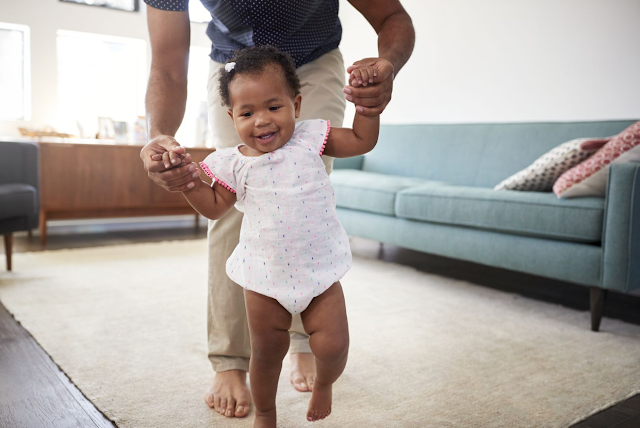Motor Development in Babies: A Month-by-Month Guide
Motor development in babies occurs in a predictable sequence, but the timeline can vary from one baby to another. Here's a general overview of motor development month by month, with tips on how to support your baby's progress:
0-3 Months
- Babies are born with reflexes, such as the grasp reflex, which causes them to tightly grip objects that touch their palms.
- They start to lift their heads briefly while lying on their stomachs.
- Visual tracking improves, and they can follow moving objects with their eyes.
Tips:
- Place your baby on their stomach for tummy time several times a day to help them strengthen their neck and back muscles.
- Offer your baby toys that they can reach for and grasp, such as rattles and soft blocks.
- Talk to your baby and sing to them to help them develop their auditory skills.
3-6 Months
- Babies begin to have better head control and can hold their heads steady when supported.
- They start to roll over, usually from tummy to back first.
- Hand-eye coordination improves, and they can reach for and grasp objects.
- They might push up on their arms while lying on their stomachs, preparing for crawling.
Tips:
- Provide your baby with a safe space to practice rolling, such as a play mat or blanket.
- Offer your baby toys that they can reach for and grasp, such as rattles and soft blocks.
- Encourage your baby to sit up by providing them with support, such as a rolled-up towel behind their back.
6-9 Months
- Babies can sit without support, usually starting with propped-up or tripod sitting.
- They might start to scoot, shuffle, or roll around to move short distances.
- Hand coordination improves further, and they can transfer objects between hands.
- They might start to use their fingers to pick up small objects using a "pincer grasp."
Tips:
- Provide your baby with a safe space to practice sitting up and moving around.
- Offer your baby toys that they can reach for and grasp, such as small blocks and pegs.
- Play games with your baby that involve hand-eye coordination, such as peek-a-boo and pat-a-cake.
9-12 Months
- Crawling often begins, whether traditional crawling on hands and knees or other unique styles.
- Babies can pull themselves to standing using furniture or support.
- They can "cruise," moving sideways while holding onto furniture for support.
- Fine motor skills develop, and they can use their fingers more precisely to explore objects.
- Some babies might take their first steps, but walking independently usually starts closer to the end of this period.
Tips:
- Provide your baby with a safe space to practice crawling and cruising.
- Offer your baby toys that they can reach for and grasp, such as small blocks and puzzles.
- Encourage your baby to stand up and take steps by holding their hands or providing them with support.
12-18 Months
- Walking becomes more stable and confident, with some toddlers able to walk independently.
- They can walk backward, squat, and stoop to pick up objects from the floor.
- Climbing becomes a favorite activity, and they might climb stairs with assistance.
- Fine motor skills continue to develop, allowing them to stack blocks, scribble with crayons, and feed themselves with utensils.
Tips:
- Provide your toddler with a safe space to practice walking and climbing.
- Offer your toddler toys that they can use to develop their fine motor skills, such as blocks, puzzles, and crayons.
- Help your toddler learn how to use utensils by providing them with age-appropriate utensils and showing them how to use them.
18-24 Months
- Running and jumping with two feet become common.
- They can kick a ball and might start to use a tricycle.
- Climbing becomes more complex, and they might attempt to climb on playground equipment.
- Fine motor skills improve, allowing for more controlled scribbling, building with blocks, and simple puzzles.
- They can use a spoon and fork for self-feeding more effectively.
Tips:
- Provide your toddler with opportunities to run, jump, and climb.
- Offer your toddler toys that they can use to develop their fine motor skills, such as blocks, puzzles, and crayons.
- Help your toddler learn how to use a spoon and fork by providing them with age-appropriate utensils and showing them how to use them.
Every baby is unique and may show significant individual differences in the timing and sequence of motor development milestones. Whilst the timeline above provides a general guide, it is important to focus on your baby's individual progress and support their development at their own pace.
If you have concerns about your baby's motor development, consult your paediatrician or a development specialist.

